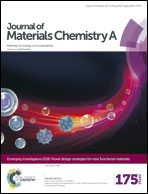Hybrid organic–inorganic solar cells based on bismuth iodide and 1,6-hexanediammonium dication†
Abstract
Heavy metal toxicity and device instability are prominent limitations in the push for commercialization of photovoltaics based on low-cost, solution-processed materials. In this study, a hybrid organic–inorganic material containing trivalent bismuth and dicationic 1,6-hexanediammonium was used as the photoactive layer in solution-processed photovoltaics. These proof-of-concept photovoltaics demonstrated a stable open-circuit photovoltage of 384 ± 12 mV and steady-state short-circuit photocurrent density of 0.101 ± 0.020 mA cm−2. In comparison to the widely studied lead-halide-based perovskites, the bismuth-based materials had superior coverage on mesoporous TiO2 layers as determined by scanning electron microscopy. Moreover, thermal stability tests demonstrated that these bismuth-based materials were more stable at higher temperatures than comparable lead-based materials.

- This article is part of the themed collection: Emerging Investigators 2016: Novel design strategies for new functional materials

 Please wait while we load your content...
Please wait while we load your content...